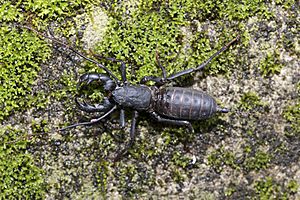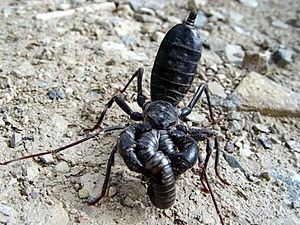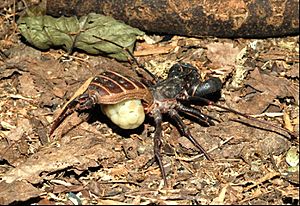Whip scorpions facts for kids
Quick facts for kids Whip scorpions, vinegaroons |
|
|---|---|
 |
|
| A Typopeltis crucifer whip scorpion. | |
| Scientific classification |
|
| Kingdom: | Animalia |
| Phylum: | Arthropoda |
| Subphylum: | Chelicerata |
| Class: | Arachnida |
| Clade: | Tetrapulmonata |
| Order: | Uropygi Thorell, 1883 |
| Families | |
| Diversity | |
| c. 23 genera, over 100 species | |
| Synonyms | |
|
Thelyphonida Latreille, 1804 (as Thélyphone) |
|
Whip scorpions, also known as vinegaroons, are amazing creatures that belong to a group of animals called arachnids. This means they are related to spiders and true scorpions. They get their name "whip scorpion" because they look a bit like scorpions and have a long, whip-like tail.
The name "vinegaroon" comes from their special defense. When they feel threatened, they can spray a liquid that smells like vinegar! This liquid contains acetic acid, which is the main ingredient in vinegar. The scientific name for this group is Uropygi, which means "tail rump" in Ancient Greek, referring to their unique tail. Another name you might hear for them is Thelyphonida.
Contents
What Are Whip Scorpions?
Whip scorpions are fascinating invertebrates. They come in different sizes, usually from about 2.5 to 8.5 centimeters (1 to 3.3 inches) long. The biggest ones, from the Mastigoproctus group, can reach up to 8.5 cm. Even though their bodies might not be huge, their legs, claws, and whip-like tail make them look much bigger.
Their body is divided into two main parts. The front part, called the cephalothorax, has their legs, pincers, and eyes. The back part, called the opisthosoma, has 12 segments. The last three segments are joined together and end with their long, whip-like tail, which can have 30 to 40 small parts.
Special Features
Like their relatives, the whip spiders, whip scorpions use only six of their eight legs for walking. Their first two legs are used like antennae to feel and explore their surroundings.
They have very large, strong pincers called pedipalps, which look like a scorpion's claws. Each pincer also has a big spine on it. Whip scorpions usually have one pair of eyes in the middle of their head and up to five pairs of smaller eyes on each side. This eye pattern is similar to true scorpions.
It's important to know that whip scorpions do not have venom glands. They can't sting you! Instead, they have special glands at the back of their abdomen. When they are bothered, they can spray a mix of acetic acid and caprylic acid. This spray smells strongly of vinegar, which is why they are called "vinegaroons."
Life and Behavior

Whip scorpions are hunters. They are active at night and mostly eat insects, millipedes, small scorpions, and other small creatures like worms and slugs. Some larger whip scorpions, like Mastigoproctus, can even hunt small vertebrates. They catch their prey and crush it using special teeth on their front legs. These creatures are helpful because they control the number of cockroaches and crickets in their habitat.
Reproduction and Life Cycle
A few months after mating, the female whip scorpion digs a deep burrow and seals herself inside. She can lay up to 40 eggs. These eggs are held in a special sac that keeps them moist and stays attached to her body.
During this time, the female doesn't eat. She holds her body in an arch so the egg sac doesn't touch the ground. The eggs slowly develop over the next few months.
When the young hatch, they are white and climb onto their mother's back. They have special suckers that help them stick there. After their first molt (shedding their skin), they look like tiny adults but have bright red pincers. Then, they leave the burrow.
The mother whip scorpion might live for up to two more years after her young leave. The young grow slowly, molting four times over about four years before they become adults. Once they are adults, they can live for another four years.
Where Do They Live?
Whip scorpions live in warm, wet places around the world. You can find them in tropical and subtropical areas, but not in Europe or Australia. There's only one known species in Africa, found in Senegal, The Gambia, and Guinea-Bissau.
They love to dig burrows using their pincers. They often bring their prey back to these burrows. You might also find them hiding under logs, rotting wood, rocks, or other natural debris. They prefer dark, humid spots and try to avoid bright light. However, some species, like the giant whip scorpion (Mastigoproctus giganteus), can be found in drier areas, such as Arizona and New Mexico in the United States.
Types of Whip Scorpions
As of 2023, scientists recognize 16 different groups, or genera, of whip scorpions that are still alive today. All of these belong to one family called Thelyphonidae.
- Etienneus
- Ginosigma
- Glyptogluteus
- Hypoctonus
- Labochirus
- Mastigoproctus
- Mayacentrum
- Mimoscorpius
- Ravilops
- Sheylayongium
- Thelyphonellus
- Thelyphonoides
- Thelyphonus
- Typopeltis
- Uroproctus
- Valeriophonus
See also
 In Spanish: Thelyphonida para niños
In Spanish: Thelyphonida para niños


